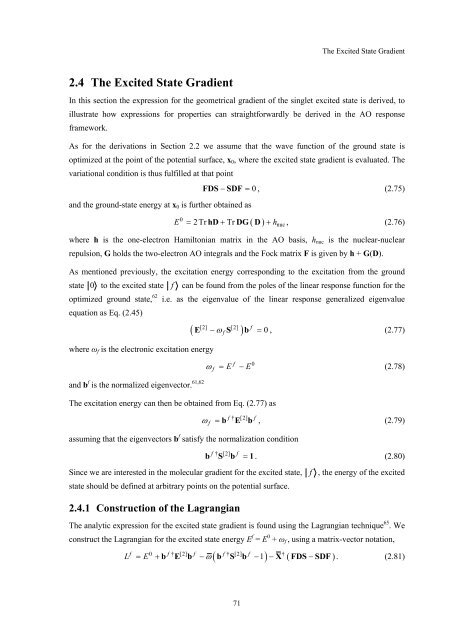Get my PhD Thesis
Get my PhD Thesis
Get my PhD Thesis
Create successful ePaper yourself
Turn your PDF publications into a flip-book with our unique Google optimized e-Paper software.
The Excited State Gradient<br />
2.4 The Excited State Gradient<br />
In this section the expression for the geometrical gradient of the singlet excited state is derived, to<br />
illustrate how expressions for properties can straightforwardly be derived in the AO response<br />
framework.<br />
As for the derivations in Section 2.2 we assume that the wave function of the ground state is<br />
optimized at the point of the potential surface, x 0 , where the excited state gradient is evaluated. The<br />
variational condition is thus fulfilled at that point<br />
FDS − SDF = 0, (2.75)<br />
and the ground-state energy at x 0 is further obtained as<br />
E<br />
0<br />
= 2TrhD + TrDG ( D ) + h , (2.76)<br />
nuc<br />
where h is the one-electron Hamiltonian matrix in the AO basis, h nuc is the nuclear-nuclear<br />
repulsion, G holds the two-electron AO integrals and the Fock matrix F is given by h + G(D).<br />
As mentioned previously, the excitation energy corresponding to the excitation from the ground<br />
state 0 to the excited state f can be found from the poles of the linear response function for the<br />
optimized ground state, 62 i.e. as the eigenvalue of the linear response generalized eigenvalue<br />
equation as Eq. (2.45)<br />
where ω f is the electronic excitation energy<br />
and b f is the normalized eigenvector. 61,62<br />
( ω f )<br />
[2] [2] f<br />
0<br />
The excitation energy can then be obtained from Eq. (2.77) as<br />
E − S b = , (2.77)<br />
f<br />
0<br />
ω f = E − E<br />
(2.78)<br />
f<br />
f † [2]<br />
assuming that the eigenvectors b f satisfy the normalization condition<br />
f<br />
ω = b E b , (2.79)<br />
f † [2] f<br />
b S b = 1. (2.80)<br />
Since we are interested in the molecular gradient for the excited state, f , the energy of the excited<br />
state should be defined at arbitrary points on the potential surface.<br />
2.4.1 Construction of the Lagrangian<br />
The analytic expression for the excited state gradient is found using the Lagrangian technique 65 . We<br />
construct the Lagrangian for the excited state energy E f = E 0 + ω f , using a matrix-vector notation,<br />
( 1) ( )<br />
f 0 f † [2] f f † [2] f<br />
†<br />
L = E + b E b −ω<br />
b S b − −X FDS−SDF . (2.81)<br />
71

















